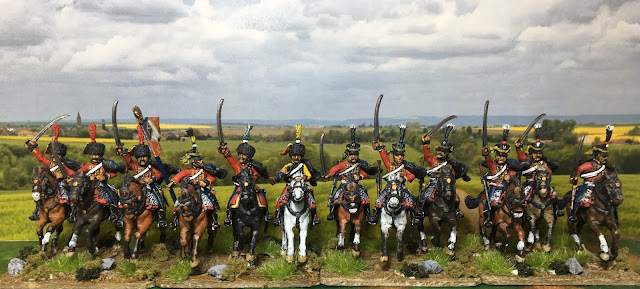Pages
Sunday, 30 September 2018
World War One - East Africa
Saturday, 29 September 2018
The 5th Hussars
Wednesday, 26 September 2018
French Napoleonic Horse Artillery
The weekend saw the completion of the painting of five Horse Artillery sets that will represent five batteries for the 1812-13. One battery will be assigned to the infantry Division, while the other four will be shared by the four cavalry divisions.
Again the figures are Perry Miniatures and are the last artillery sets needed for this collection.
Saturday, 22 September 2018
More 1812-13 French
Friant’s Infantry division
Monday, 17 September 2018
Napoleonic Game
Our regular Sunday game (over the last weekend) was a Napoleonic game.
It was a largely adhoc setup designed as a straight up fight. A Franco/German force consisting of two French infantry brigades, with cavalry and artillery attached and supported by a similar sized Bavarian and Wurttemberg force, took on a Prussian division and two Russian divisions. Deployment was done by dice roll per command, the highest score deploying first, then the next highest and so on. Each command could deploy up to half way across the table and any opposing deployment had to deploy a minimum of 600mm away. In the end no one deployed up to the halfway mark, everyone wanted some manoeuvre space.
On the Franco/German side the French held the left, the Wurttembergers the centre and the Bavarians the right rear, while the two Russian divisions held the right (opposite the French) and centre (against the Wurttembergers) and the Prussians the left.
Action commenced with the French moving to attack the town on their left hand side of the table. They intended to drive through the town and then swing their cavalry wide against the Russian right. They quickly occupied on of the large built up areas, only just beating a unit of Russian jagers into the place, but when the Russians occupied the other two areas of the town a lengthy firefight started amongst the buildings that would last most of the day.
Action on the French front continued with the Russians pushing forward to drive them off. After some initial success the French musketry against the dense Russian formations began to tell and their advance began to falter.
In the centre the both side stood relatively stationary either side of a broad ridge. Finally the Russians moved toward the crest, ready to march over and engage the Wurttembergers. The Wurttembergers were up to the challenge and crested the ridge, opening fire on the Russian columns. A epic clash between six battalions on each side was on the cards. Before the Russians could return the fire, the Wurttembergers seized the initiative and charged forward.
However, the Wurttembergers had done enough damage to the lead Russian brigade for the Russians to give up the ghost and then dispersed, as did another of the Russian brigades on the right, surrendering the town to the French.
The Bavarians and Prussians exchanged long range fire, but were not seriously engaged.
Meanwhile the French continued to grind away at the Russians to their front and soon cleared that front of Russians. The French now dominated the flank of the remaining Russians in the centre.
The end was near for the Russo-Prussian command. The Bavarians were finally stirred into action, advancing agianst the point of junction bteween the Prussians and Russians. One of the Bavarian battalions facing the Russians was badly cut up, but their musketry of their other battalions cut into the Prussians and they began to recoil. When the second Wurttemburg brigade came forward there was little that the Russians could do but take it on the chin. Two of the Russian battalions were easily routed, but the other four held their ground and pushed some of the Germans back. The fight see-sawed for a turn and while the fight continued one of the Prussian brigades gave up the fight and quit the field.
Then in one turn the Wurttembergers, the remaining Russians and one of the Bavarian brigades dropped below their brigade morale level and quit the field. This left a single Prussian brigade on the field against the French and a single Bavarian brigade. With this collapse on the Russo-Prussian side, army morale collapsed and the remaining troops quit the field.
Tuesday, 11 September 2018
9th Hussar Regiment
In previous posts I have admitted to my hussar addiction. I have also admitted to a bit of hussar remorse – that feeling of “OH WHY…” as soon as I start to paint them.
This unit of Perry Miniatures plastic French hussars, for my French 1812-13 project certainly feeds my addiction, but I didn’t get the remorse this time…in fact I really enjoyed painting them.
These figures assembled really easily and painted just as easily too. I made it easier for myself by painting the pelisses separately and gluing them on after the rest of the figure was completed. Not having to work around a cast pelisse made the work so much easier and pleasurable.
I have another unit of hussars to do for what will be Burthe’s 8th Light Cavalry Brigade in Pajol’s 2nd Light Cavalry Division at Borodino. These figures are enroute and should arrive sometime this week.
Thursday, 6 September 2018
French 1812 Infantry
It has been a busy couple of weeks on the painting table since we go back from holiday. In that time I have completed three French 1812-13 battalions and started another two – 83 figures in all.
Now in fairness I had done 42 figures before I went away, but simply had not based them up.
First up is the 2nd battalion, 15th Légère.
Next is 3rd Battalion 48th de Ligne.
Finally is 4th Battalion 48th de Ligne.
The 3rd/15th Légère and 5th/48th are waiting for the command figures to arrive – next week I hope.
Meanwhile passing through the uniform store at present is a regiment of hussars, the 9th.


























































